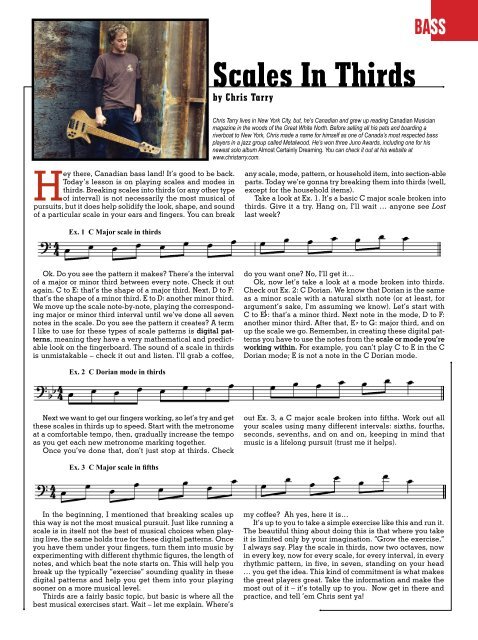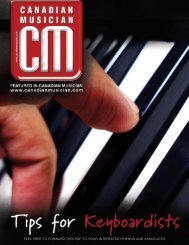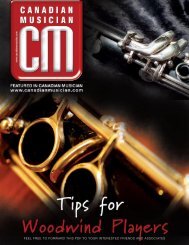Scales In Thirdsby Chris TarryBassChris Tarry lives in New York City, but, he’s <strong>Canadian</strong> and grew up reading <strong>Canadian</strong> <strong>Musician</strong>magazine in the woods of the Great White North. Before selling all his pets and boarding ariverboat to New York, Chris made a name for himself as one of Canada’s most respected bassplayers in a jazz group called Metalwood. He’s won three Juno Awards, including one for hisnewest solo album Almost Certainly Dreaming. You can check it out at his website atwww.christarry.com.Hey there, <strong>Canadian</strong> bass land! It’s good to be back.Today’s lesson is on playing scales and modes inthirds. Breaking scales into thirds (or any other typeof interval) is not necessarily the most musical ofpursuits, but it does help solidify the look, shape, and soundof a particular scale in your ears and fingers. You can breakany scale, mode, pattern, or household item, into section-ableparts. Today we’re gonna try breaking them into thirds (well,except for the household items).Take a look at Ex. 1. It’s a basic C major scale broken intothirds. Give it a try. Hang on, I’ll wait … anyone see Lostlast week?Ex. 1 C Major scale in thirdsOk. Do you see the pattern it makes? There’s the intervalof a major or minor third between every note. Check it outagain. C to E: that’s the shape of a major third. Next, D to F:that’s the shape of a minor third. E to D: another minor third.We move up the scale note-by-note, playing the correspondingmajor or minor third interval until we’ve done all sevennotes in the scale. Do you see the pattern it creates? A termI like to use for these types of scale patterns is digital patterns,meaning they have a very mathematical and predictablelook on the fingerboard. The sound of a scale in thirdsis unmistakable – check it out and listen. I’ll grab a coffee,do you want one? No, I’ll get it…Ok, now let’s take a look at a mode broken into thirds.Check out Ex. 2: C Dorian. We know that Dorian is the sameas a minor scale with a natural sixth note (or at least, forargument’s sake, I’m assuming we know). Let’s start withC to E : that’s a minor third. Next note in the mode, D to F:another minor third. After that, E to G: major third, and onup the scale we go. Remember, in creating these digital patternsyou have to use the notes from the scale or mode you’reworking within. For example, you can’t play C to E in the CDorian mode; E is not a note in the C Dorian mode.Ex. 2 C Dorian mode in thirdsNext we want to get our fingers working, so let’s try and getthese scales in thirds up to speed. Start with the metronomeat a comfortable tempo, then, gradually increase the tempoas you get each new metronome marking together.Once you’ve done that, don’t just stop at thirds. Checkout Ex. 3, a C major scale broken into fifths. Work out allyour scales using many different intervals: sixths, fourths,seconds, sevenths, and on and on, keeping in mind thatmusic is a lifelong pursuit (trust me it helps).Ex. 3 C Major scale in fifthsIn the beginning, I mentioned that breaking scales upthis way is not the most musical pursuit. Just like running ascale is in itself not the best of musical choices when playinglive, the same holds true for these digital patterns. Onceyou have them under your fingers, turn them into music byexperimenting with different rhythmic figures, the length ofnotes, and which beat the note starts on. This will help youbreak up the typically “exercise” sounding quality in thesedigital patterns and help you get them into your playingsooner on a more musical level.Thirds are a fairly basic topic, but basic is where all thebest musical exercises start. Wait – let me explain. Where’smy coffee? Ah yes, here it is…It’s up to you to take a simple exercise like this and run it.The beautiful thing about doing this is that where you takeit is limited only by your imagination. “Grow the exercise,”I always say. Play the scale in thirds, now two octaves, nowin every key, now for every scale, for every interval, in everyrhythmic pattern, in five, in seven, standing on your head… you get the idea. This kind of commitment is what makesthe great players great. Take the information and make themost out of it – it’s totally up to you. Now get in there andpractice, and tell ’em Chris sent ya!
Writing A Memorable Bass Lineby Brian MinatoBassWhat is it that makes a bass line both memorable as well as supportive to the song in whichit was created? What are the things that can inspire the creation of a bass part that gives asong forward momentum? What types of bass lines can stand alone?Like most musicians, you can probably often be foundsitting around absentmindedly noodling away atseemingly nothing on your instrument. This is wheninspiration can strike! The previous nonsensicalnoodle session can quickly become the foundation of anunforgettable bass line and, hopefully, part of a song whichmight live forever! I find having some sort of recording devicevery handy just so you can document your latest masterpiece.These days, your options for recording ideas are almost limitless:cell phones, BlackBerries, handheld digital recorders,laptops, and more sophisticated recording devices. Thesevarious recording tools will allow you to have a copy shouldyou really want to explore your initial ideas.Coincidentally, I had just been asked to DJ an upcomingparty when I got the call about this column, so I’d alreadybeen going through my iTunes library, creating playlistsand listening to a lot of songs. As a result, there’s a lot ofbass! Listed below are songs which totally fit the bill forour topic:”Walking On The Moon,” Sting, The Police, Regatta de Blanc”Come Together,” Paul McCartney, The Beatles, Abbey Road”Money,” Roger Waters, Pink Floyd, Dark Side of the Moon”Sunday Papers,” Graham Maby, Joe Jackson, Look Sharp”Safe From Harm,” Massive Attack (Billy Cobham Sample),Blue LinesI tried to pick examples that are fairly well-known, justso my points of reference aren’t lost. The one thing commonto each song is that if you took away the vocals, the otherinstrumentation, etc., and only had the bass parts going, youwould probably still be able to name the song being played.That, to me is the biggest distinction between a bass linebeing able to stand on its own and one that is of a more commonplace,garden variety type. When I say commonplace, Idon’t mean it in any sort of derogatory way. I mean it morelike this: if you did the same thing to a country-esque songwith a root-5th type of bass line, it could fit into any numberof songs, and if played on its own would not really give aclue as to the name of the song.When I hear “Walking On The Moon,” “Come Together,”and Pink Floyd’s “Money,” I get the distinct impression thosebass lines were very pivotal in directing what the other musicianscame up with. Each bass part has such a strong,signature-like quality. I feel like they were written apart fromthe actual songs themselves. To me, they are the kinds ofparts upon which other instruments can build, creating amore unique sound. They are the kinds of parts that caninspire other musical events to occur. Consider the sound,the grooves, and the push and pull between the Sting/StewartCopeland, Paul McCartney/Ringo, and Roger Waters/NickMason rhythm sections on those tracks. Check out thosesongs and see what you think.On the other hand, the “Sunday Papers” and “Safe FromHarm” bass lines seem to have a more arranged feel to them– rather like they were written or created alongside with otherexisting musical parts. Graham Maby’s iconic herky-jerkypart from Joe Jackson’s post-punk classic “Sunday Papers”feels like the sum of the guitar and drum parts all workingtogether. The sound of Massive Attack has a strong basis inthe world of turntables, samples, loops, and technology. “SafeFrom Harm”’s heavy, repetitive groove owes its debt to thewicked sample of Lee Sklar’s bass from 1973’s jazz fusion gem“Stratus” off of the Spectrum album by Billy Cobham. Again,check out those songs and see what impressions you get.What I notice about bass lines like those previously mentionedis that you can sing them or hum them with relativeease. Try it. You’ll see what I mean. That, to me, is anotherhallmark of a memorable bass line. Even though each basspart discussed above has a distinctiveness which allows itto be recognizable apart from the song it comes from, allthose parts ultimately lend themselves to the support of thesong. They are there to provide a solid low-end groove, toinspire the other musicians, and to make it easier for themto access to their creativity.Good luck!Brian Minato is the bassist for Sarah McLachlan. He is a Vancouver-based musician/producer currently working with Anthill, Sandy Scofield, boywonderbread, JenniferCampbell, Hiroaki Takashiba, The Blue Alarm, and other artists.Visit these websites to check what he’s up to.www.myspace.com/anthillcanadawww.sandyscofield.comwww.myspace.com/cozurewww.myspace.com/boywonderbreadwww.24hourcardlock.com/www.myspace.com/hirotakashibawww.myspace.com/thebluealarmwww.eden-electronics.com/artists/brianminato.aspwww.line6.com/artists/220





